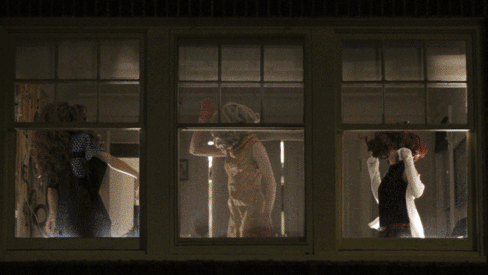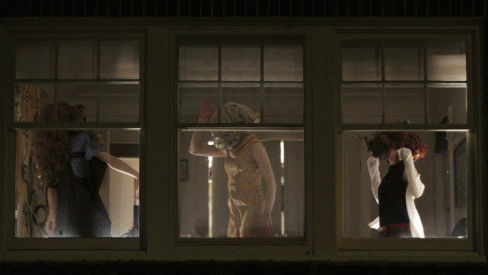With the 2013 Northwest New Works Festival in the history blogs, it’s time to explore its themes of blood, dirt, and death — and going on too long. So many of the shows this year would have been greatly improved if they’d simply known when to stop. Conversely, some of the most compelling were reductions of longer works. I can’t offer a complete list (I missed the entire first weekend’s showcase) but here is the best of what I saw.
The Satori Group‘s The Land is Always Known, which closed the festival, is stunning even in excerpted form as a work-in-progress. What if we imagine ourselves first-generation settlers in a land of non-violence, asks the Group, beset by angry ghosts taunted by our existence? Phoebe (Greta Wilson) addressed the audience from in front of the curtain, talking about such ghosts, which she’d been told — emphatically, repeatedly — didn’t exist in her family. They’d been exorcised, which her younger ears misheard as “exercised.” Maybe you’re not into ghosts, she added, that was okay, you could take it as a metaphor. There was a folk-country song about a famous, unruly Ruth (Abigail Nessen Bengson, of those The Bengsons, who supplied the music), with a ghost chorus who interpolated eerie wheezes and sighs into the lyrics and danced (movement by Molly Sides, direction by Caitlin Sullivan), and then Elias (Quinn Franzen) showed up to cast a menacing spell over Greta. Their dialogue (written by Spike Friedman) was stilted because Elias wasn’t really talking with anyone, he was making demands and issuing latent threats. Later, Ruth appeared in person, an ur-woman with her own rousing anthem, as a tattered fence-row by set designer Montana Tippett lifted up to become a sky-filling, raggedy cloak. In just this glimpse, the show looked and sounded phenomenal.
Land, violence, and relationship also converged in DUELS: Orange, a three-hander written by Nick Stokes and directed by José Amador. Again, an excerpt from a larger work, it opened with the two men shooting each other, falling backward into two garden beds. Daniel Christensen plays the money manager who’s shown up suddenly at his wife’s (ex-wife’s?) country home, post-economic blow-up. He’d like them to get back on track, but she (Aimée Bruneau) is beguiled by neighboring gardener Carter Rodriquez. As their opening duel and resurrection implied, they’re locked into a cycle, but Amador has the trio humming like a clock powered by Christensen’s brisk, sociopathic flippancy and Rodriquez’s English-and-Spanish bob-and-weave, while Bruneau rejoices in her carrots.
The program notes for Josh Martin’s Leftovers bore the gnomic inscription: “For my mother, who no longer has a fear of falling.” If you had not noticed that, what you saw was an undeniably impressive technical feat: Martin turning his body movements into a strobe-lit succession of events — just without a strobe light. It wasn’t your father’s pop-and-lock because the emphasis wasn’t on that robotic stiffness; it was a minutely-observed capturing of a number of falls, from the initial loss of balance, to the attempt to break the fall, and the body’s settling on the floor. My only criticism of the piece is that its length began to subtract from its impact, and that the diffidence around letting the audience know what is being portrayed is perplexing.
Paul Budraitis continued to steer well away from comedic work with Clear Blue Sky, directed by Braden Abraham, with artistic direction by L.B. Morse. This show, based on real-life incidents, opened with him sitting on a large box made of particle board, perhaps 12 feet high, and watching footage that seemed to be shot from the cockpit of a low-flying plane. Then he descended into the box via a door in its ceiling, and cameras mounted inside showed him projected (video by Leo Mayberry) on the outside of the box. Budraitis’s narrative pulled together a number of incidents where death (and news of death) arrived “out of the blue” — plane crash, warfare — and the impact that has on the living, the derangement it can cause. Though he’s narrating, Budraitis seems to become these people, his face registering shock (or flat with denial), and so it becomes that kind of performance art where the artist takes upon (in this case) himself a trauma: not the death itself, but how to talk about it to someone else.
Dance group The New Animals had death in mind as well: TRE (where were you), their Markeith Wiley-choreographed remembrance of Joe Sodd III, is another “excerpt from a larger work,” set to music by Barry Sebastian. There was a free-and-easy feeling among the dancers, as they arrived on stage and began setting out red SOLO cups, shared a drink. All are charismatic, to use the jargon, movers: Jamie Karlovich, Molly Sides, Callie Swedberg, Sean Tomerlin, and Wiley himself. The choreography often blended modern dance with breakdance; Tomerlin and Wiley had a physical duet, and what I think of as the “Matrix foot” (leg slowly extended parallel to the floor, then held and tensed, as if completing a martial arts move) popped up again and again. It’s a bit hermetic for the audience, watching a memorial for someone they likely didn’t know, but the dancing stands (or spins) on its own.
Paris Hurley’s Beware the Illusion of Perfection combined dance, spoken word (by ilvs strauss), and music (by Hurley) to present perspectives on selfhood and body image. It featured a Greek chorus of sorts — maybe caryatids is more apt, they didn’t sing — who, in bra and panties, mutely presented a range of body types. There were surrealist gestures: a woman sat in a pile of dirt, clawing at it and herself, another stood with her hair falling over her face. It’s an evocative piece. It would have been interesting to see it next to Allie Hankins’ Misshapen Pearl, which seemed to have something similar on its mind. The performers here, costumed by Rose Mackey, were baggy and saggy, with disfiguring lumps, none of which seemed to dent their self-image at all. They presented a sort of vaudeville-era dance line, each repeating a spotlight number, but eventually it began to feel like vamping.
Harp Song for a Radical, directed by Jeffrey Fracé, was “inspired” by Marguerite Young’s book about Eugene V. Debs but tells the story of a band of djs at an underground radio station who would like to overthrow the state on 10 watts. It came to feel a bit scattershot and frenetic, but the characters had truth to them, and Montana Tippett’s rolling radio studio kept playing the hits for ensemble dance pieces (some with Wade Madsen, even) that were genuinely engaging. It ends with a dj committing suicide, in despair that change can be effected, but you know the music won’t stop.
I won’t go so far as to say “only in Seattle” about The Eternal Glow Project, but it certainly seemed up our alley: it played like a cross between a TEDx talk (charts and graphs!) and an awkwardly earnest stand-up diary reading. Tim Smith-Stewart introduced his friend Jeffrey Azevedo, one of the smartest people he knows, and began to discuss his personal life’s trials and tribulations while Azevedo explained science’s notions about the heat-death of the universe. Smith-Stewart is funny, though he’s getting at the way mortality (or intimations of it) gnaw at us, but as an extra bonus, the show also throws in the construction and deconstruction of a wooden bench, which is at one point piled on top of Smith-Stewart as he ponders crushing implications.

